新课标高中英语语法系统全解状语从句(一)
- 格式:doc
- 大小:23.00 KB
- 文档页数:4
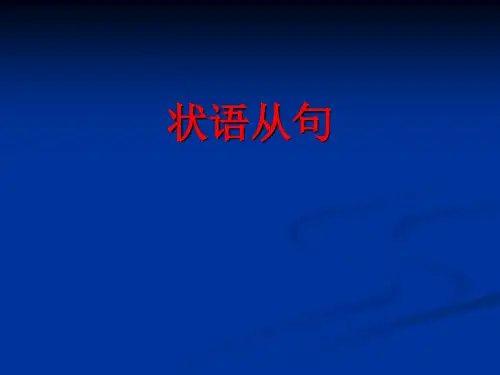
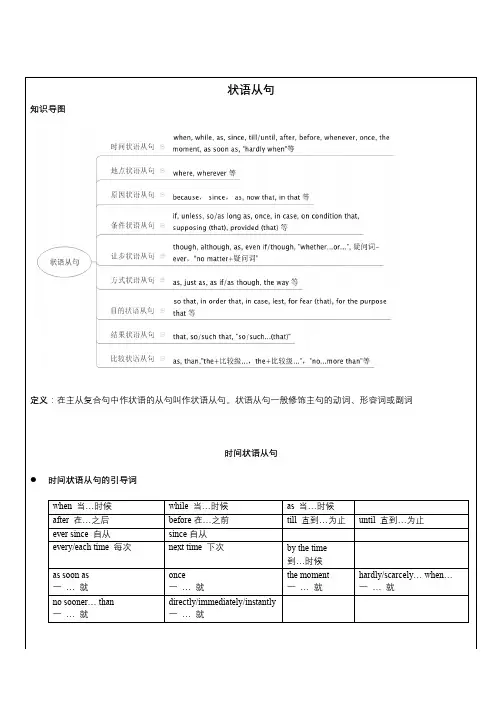

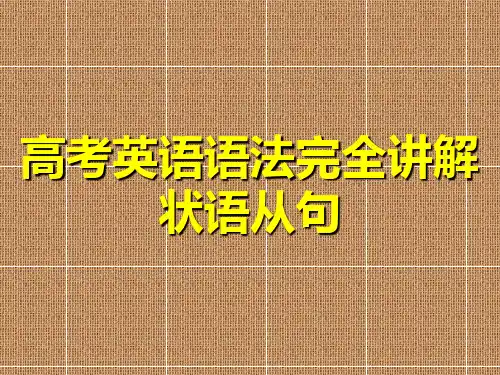
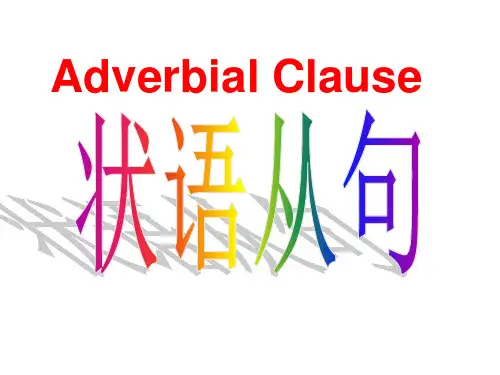


状语从句那你帮小新造个英文句子吧~~~上面这个句子有什么特点吗?一、状语从句的概念用来修饰主句中的动词,副词和形容词的从句叫状语从句。
时间状语从句地点状语从句条件状语从句目的状语从句状语从句分类原因状语从句结果状语从句方式状语从句比较状语从句让步状语从句1. 时间状语从句4. 只能用as的情况1) as表示“随着……”之意时;2) as表示“一边……一边……”时;3)当表示主从句两个短暂性动作同时发生时。
5. 表示“一……就……”的连词或短语1) as soon as,当主句是一般将来时,从句必须用一般现在时表示将来。
2)在hardly.when/ scarcely.when/ no sooner.than结构中,当hardly/ scarcely/no sooner 放在句首时,主句必须用倒装语序;主句的时态须用过去完成时,从句须用一般过去时。
3) the moment,the minute,the second,the instance后直接接从句。
4) immediately,instantly后直接接从句。
6. every morning,every evening,every time,every day,every year(每……)后直接接从句。
7. “it was+时间点+when从句”it指时间点,时间前无介词,when从句是状语从句;当主句是一般将来时,when 从句用一般现在时。
8. before1)…before.表示“没有来得及做某事就……”,主句经常用过去完成时,从句用一般过去时。
2)“it was(not)十一段时间+before从句(一般过去时)”主句是肯定句时,意为“过多长时间才……”;主句是否定句时,意为“没过多久就……”。
3)“it will be(not)十一段时间十before从句(一般现在时)”主句是一般将来时,从句要用一般现在时表示将来。
9. until1)(not)…until…一肯定句中主句的谓语动词必须是延续性动词;否定句中主句的谓语动词经常是非延续性动词,也可以是延续性动词。

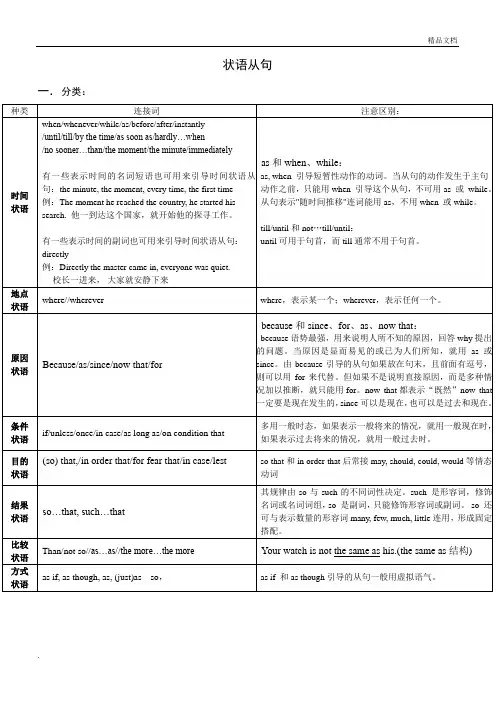
状语从句一.分类:when (当……的时候) while (在……期间) as (当……的时候, 一边……一边……)before (在……之前) since (自从……以来) till/until (直到) hardly…when… (刚……就) as soon as (一……就……)after (在……之后) not…till/until(直到……才)no sooner…than…(刚……就) 地点状语从句:where (在那里) wherever(无论哪里)原因状语从句:because (因为) since (因为,既然) as (由于) for (为了) now that(既然)目的状语从句:(so)that=in order that(以便)so as(not)to (以便[不])in case(以免)lest(以免)结果状语从句:so+adj./adv.+that(如此……以致)so that(结果……)such+n.+that(如果……以致)that(所以,因此)让步状语从句:though/although不可同but连用。
though/although (虽然)however (可是)even though/if(即使)no matter+what/which/where/who/when =whatever/whichever/wherever/whoever/whenever(不论什么/哪一个/哪里/谁/何时)比较状语从句:as (正如)as…as(和……一样)not as/so … as (不如……)than(比……更)the+比较级…+the+比较级(越……越……)条件状语从句:if(假设)unless(如果不)so long as(只要)on condition that (如果)方式状语从句:as(像……那样地)just as(正像)as if(好像)as though(好像)二.各种状语从句的简化方法:1作状语。
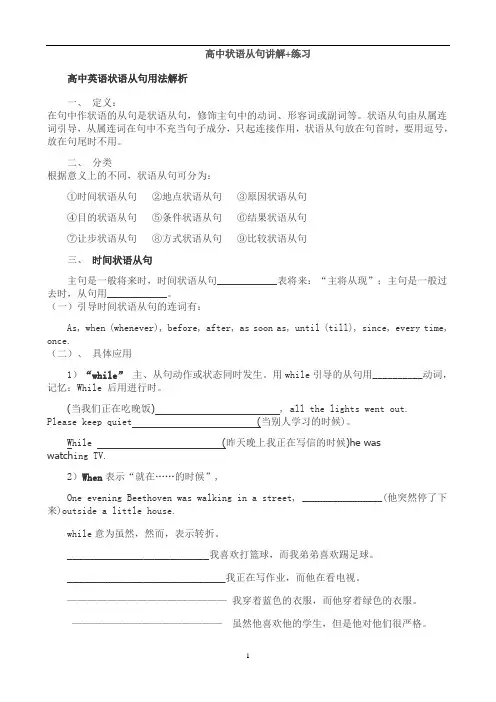
高中状语从句讲解+练习高中英语状语从句用法解析一、定义:在句中作状语的从句是状语从句,修饰主句中的动词、形容词或副词等。
状语从句由从属连词引导,从属连词在句中不充当句子成分,只起连接作用,状语从句放在句首时,要用逗号,放在句尾时不用。
二、分类根据意义上的不同,状语从句可分为:①时间状语从句②地点状语从句③原因状语从句④目的状语从句⑤条件状语从句⑥结果状语从句⑦让步状语从句⑧方式状语从句⑨比较状语从句三、时间状语从句主句是一般将来时,时间状语从句____________表将来:“主将从现”;主句是一般过去时,从句用____________。
(一)引导时间状语从句的连词有:As, when (whenever), before, after, as soon as, until (till), since, every time, once.(二)、具体应用1)“while”主、从句动作或状态同时发生。
用while引导的从句用__________动词,记忆:While 后用进行时。
(当我们正在吃晚饭) , all the lights went out.Please keep quiet(当别人学习的时候)。
While (昨天晚上我正在写信的时候)he waswatch ing TV.2)When表示“就在……的时候”,One evening Beethoven was walking in a street, ________________(他突然停了下来)outside a little house.while意为虽然,然而,表示转折。
__________________________我喜欢打篮球,而我弟弟喜欢踢足球。
_____________________________我正在写作业,而他在看电视。
————————————————我穿着蓝色的衣服,而他穿着绿色的衣服。
———————————————虽然他喜欢他的学生,但是他对他们很严格。
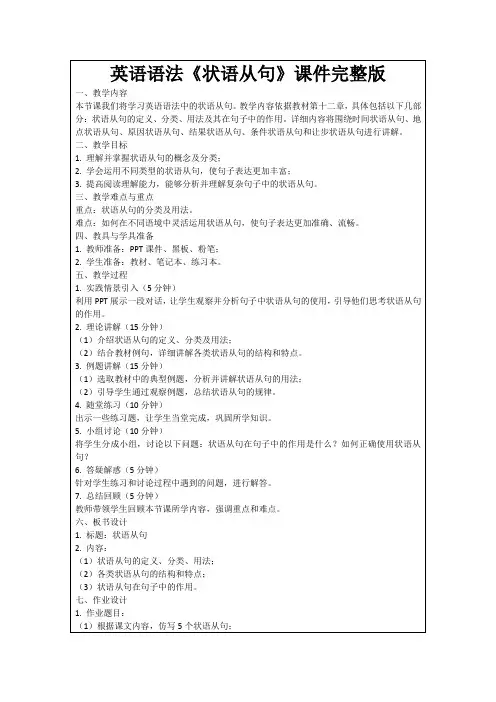
状语从句状语从句在句中作状语,可分为:时间、条件、让步、原因、目的、结果、比较、地点、方式状语从句。
一、时间状语从句弓丨导时间状语从句的连词有:whe n, as, while, un til, not …un til, before, after, sin ce, the minute,the moment, each( every, next, the first) time 等。
时间状语从句中一般用一般现在时或一般过去时。
1. When , while, as都可解释为"当'、'的时候”但侧重点有所不同。
1) WhenEg: When I arrived home , I had a little rest.注意点:when从句的主语与主句主语相同,谓语动词是be动词时,从句主语和be可以省略。
Eg: When (she was) walking along the street, she met her class teacher.2) AsAs 除了表示“当'''的时候”,还可表示为“一面'''一面”,“随着”Eg: He sang as he danced.一面'''一面)You will grow wiser as you grow older.( 随着)3) While 表示“当'''的时候” 强调主句的动作和从句的动作同时发生,从句一般用进行时,从句动词必须是延续性动词。
Eg: While we were working, they were having a rest.While (they were) having a discussion, they got very confused.注意点:while 有对比的含义,解释为“然而” 。
eg: I prefer black tee, while he likes coffee.2. until, not…until表示"直到'、'才”,在肯定句中主句常用延续性动词;在否定句中主句常用短暂性动词。
状语从句●定义:用“引导词+述语序”作状语●状语:修饰动作,把句子“壮大”He speaks English well.(方式状语)The sun rises in the east and sets in the west.(地点状语)●九种状语从句:时间、地点、原因、结果、方式、目的、条件、让步、比较I love you you love me(1)when—时间状语(2)where—地点状语(3)because—原因状语(4)so—结果状语(5)as—方式状语(6)in order that—目的状语(7) I will love you if you love me.—条件状语(8) I won’t love you even if you love me.—让步状语(9)more than—比较状语意思不同,形式不同,形意相关I read English loudly in the open air every morning.方式状语地点状语时间状语用从句形式当状语,即状语从句(一)时间状语从句引导词●till, untilA until B:A一直延续到B出现或发生就停止I slept until noon.I didn’t go to bed until midnight.I entered the room until 6:30.I didn’t enter the room until 6:30.as soon as,the minute, the moment, the instant, immediately, directlyno sooner…than, hardly…when, scarcely…when(结合倒装句)●before, after, 完成+since(自从)+过去时间--what was the party like?--Wonderful. It’s years I enjoyed myself so much.A. afterB. beforeC. whenD. sinceIt is 50 years the PRC was founded.A. afterB. beforeC. whenD. sinceI knew Mr. Green I knew Mrs. Green.A. long beforeB. before long过不了多久C. long agoD. after long●when, while, as(当)(1)while持续性动作或状态D on’t laugh while you are praying.(2)as伴随或较短的时间As I was speaking, some of you were sleeping.Mother was worried because little Alice was ill, especially father was away in France.A. asB. thatC. during介词,后面只能跟名词D. if(3)when当…时/正在这时,突然…/正要做某事,突然…When I was young, I listened to the radio.I was doing my homework when the earthquake happened.I was about to do my homework…Why do you want a new job you got such a good one already?A. thatB. whereC. whichD. whenhis plane arrived at the airport in Paris, I had already left for Los Angeles.A. WhileB. UntilC. WhenD. AsIt just isn’t fair. I was working as a waiter last month, my friends were lying on the beach.A. WheneverB. thoughC. forD. while延续的感觉(二)其他状语从句●whereAfter the war, a new school building was put up there had once been a theatre.A. thatB. whereC. whichD. when●because, since, asIt was he was ill that he didn’t go with us.A. since既然B. for为推断找解释C. as由于D. because直接原因或根本原因It must have rained last night, the ground is wet this morning.A. forB. sinceC. becauseD. asThe ground is wet, because it rained last night.He must be ill, he looks so pale.A. sinceB. becauseC. asD. for_____ you are free tonight, why not drop in and play chess with me?A. ForB. Since既然C. BecauseD. Even if●so…that…/ such…that如此…以致于Father was busy in working he often forget rest or meals.A. very, thatB. so, thatC. such, asD. enough, as●as(以…方式),as if/ as thoughShe doesn’t speak her friend, but her written work is excellent.A. as well asB. so often asC. so much asD. as good as●unless=if +notYou will be late you leave immediately.A. unlessB. untilC. ifD. or●though, although, even if, even thoughwhile(虽然,而)whatever, whoever, wherever, whenever, however, whicheveras(尽管)thanAlthough he is a man, he likes skirts. = Man as he is, …Try he might, he couldn’t get out of difficulty.A. whenB. whereC. tillD. as, he can never solve the problem alone.A. Clever and intelligent he isB. Clever and intelligent as he isC. As he is clever and intelligentD. As clever and intelligent he is, mother will wait for him to have dinner together.A. However late is heB. However he is lateC. However is he lateD. However late he is●now that(既然), in that(因为)●so that, in order that●lest, in case, for fear that(以防)if, as/ so long as, onceThe volleyball match will be put off if it .A. will rainB. rainsC. rainedD. is rainingThe new secretary is supposed to report to the manager as soon as she .A. will arriveB. arrivesC. is arrivingD. is going to arriveRemember to send me a photo of your son next time you to me.A. writeB. will writeC. are writingD. would write。
高中英语语法系统全解第1章动词时态第2章被动语态第3章虚拟语气第4章情态动词第5章动词不定式第6章动词的ing形式第7章过去分词第8章独立主格结构第9章名词性从句第10章定语从句第11章状语从句(一)第11章状语从句(二)第12章直接引语和间接引语第13章倒装第14章强调第15章省略第16章主谓一致动词时态--一般时第一章动词时态(一)在英语中,不同时间发生的动作或存在的状态,要用不同的动词形式来表示,这就叫做动词的时态。
一、一般时一般时包括一般现在时、一般过去时、一般将来时和一般过去将来时。
A.一般现在时进行时完成时第二章被动语态(一)He was married in Beijing.他是在北京结婚的。
(被动语态)虚拟语气B.状语从句中的虚拟语气动词不定式过去分词D.动词的-ed形式作状语独立主格结构说什么话就离开了会议室。
(without不能省略)名词性从句三同位语从句同位语从句用于对前面的名词作进一步解释,说明名词的具体内容。
同位语从句一般由that引导,但也可以由whether以及连接代词和连接副词引导。
A.同位语从句一般跟在名词fact,hope,idea,news,doubt,suggestion,information,opinion,decision,dis covery,truth,promise,statement,problem,rule等的面。
They were all very much worried over the fact that you were sick.对你生病这件事,他们都很焦虑。
Where did you get the idea that I could not come你在哪儿听说我不能来?I have no idea whether he'll come or not.我不知道他是否来。
We haven't yet settled the question where we are going t spend our summer vacation.到哪儿去度暑假,这个问题我们还没有决定。
(完整版)状语从句超详细讲解状语从句是复合句的一种,它能够起到修饰主句的作用。
本文将详细讲解状语从句的定义、分类以及使用方法。
定义状语从句是一个修饰、说明主句的从句。
它能够表达时间、地点、原因、条件、目的、方式等等不同的状况或情况。
分类根据状语从句的引导词,我们可以将其分为以下几种类型:1. 时间状语从句:用于表示何时发生或发生过的情况。
常用引导词有:when, while, as, before, after, until, since, as soon as等。
2. 地点状语从句:用于表示事件发生的地点。
常用引导词有:where, wherever。
3. 原因状语从句:用于表示事件的原因。
常用引导词有:because, since, as等。
4. 条件状语从句:用于表示某种条件下发生的情况。
常用引导词有:if, unless, provided that, as long as等。
5. 目的状语从句:用于表示主句中的动作或状态的目的。
常用引导词有:so that, in order that。
6. 方式状语从句:用于表示主句中的动作或状态发生的方式。
常用引导词有:as, as if, as though。
使用方法在使用状语从句时,需要注意以下几点:1. 引导词的选择要准确。
不同类型的状语从句需要选择相应的引导词,以确保表达的准确性。
2. 状语从句的位置可以灵活调整。
可以将状语从句放在主句之前、之后或中间,但要注意语序的调整,以保证句子的通顺。
3. 使用适当的标点符号。
根据句子结构和语义需要,可以在状语从句和主句之间使用逗号、连词等标点符号。
4. 注意主从句的时态和语态一致性。
主句和状语从句之间的动作发生时间要一致,并保持相同的语态。
总结状语从句是一种修饰主句的从句,能够表达时间、地点、原因、条件、目的、方式等不同状况。
根据引导词的不同,状语从句可以分为时间状语从句、地点状语从句、原因状语从句、条件状语从句、目的状语从句和方式状语从句。
高中英语语法系统全解第1章动词时态第2章被动语态第3章虚拟语气第4章情态动词第5章动词不定式第6章动词的ing形式第7章过去分词第8章独立主格结构第9章名词性从句第10章定语从句第11章状语从句(一第11章状语从句(二第12章直接引语和间接引语第13章倒装第14章强调第15章省略第16章主谓一致动词时态--一般时第一章动词时态(一在英语中,不同时间发生的动作或存在的状态,要用不同的动词形式来表示,这就叫做动词的时态。
一、一般时一般时包括一般现在时、一般过去时、一般将来时和一般过去将来时。
A.一般现在时1.一般现在时的构成一般现在时主要用动词原形来表示。
主语是第三人称单数时,动词后面要加-s或-es。
“我’为开头做称呼的是第一人称‘你’怎么怎么样是第二人称‘他她它’是第三人称第三人称就是第三人称转述。
例:小兰对妈妈说:“我要出去玩了”第三人称:小兰对妈妈说,她要出去玩了。
第三人称,就是说是叙述性质的,没有人的语言,是旁白在记叙!以我的角度说,就是第一人称;以和你说的角度说,就是第二人称;站在事情外说事情,他怎么怎么样,那就是第三人称了They want good jobs.他们想要好的工作。
The coat matches the dress.外衣和裙子很相配。
This work does not satisfy me.这项工作我不满意。
Do you understand?你懂了吗?2.一般现在时的用法①一般现在时的基本用法a.表示现在习惯性的动作或存在状态He always takes a walk after supper.晚饭后他总是散散步。
Everyone is in high spirits now.现在大家都情绪高涨。
b.表示客观事实或普遍真理The sun rises in the east and sets in the west.太阳从东方升起在西方落下。
Sound travels faster through water than it does through air.声音在水中的传播速度要比在空气中快。
索引目录第一主题高中英语语法系统全解(一)第1章动词时态 2-4楼第2章被动语态5-7 楼第3章虚拟语气9-11 楼第4章情态动词 12-16楼第5章动词不定式 17-20 楼第6章动词的ing形式 21-24楼第7章过去分词 25-27楼第8章独立主格结构 28-30楼第9章名词性从句 31-33楼第10章定语从句 35-40楼第11章状语从句(一) 40-45楼第11章状语从句(二)第12章直接引语和间接引语第13章倒装第14章强调第15章省略第16章主谓一致动词时态--一般时第一章动词时态(一)在英语中,不同时间发生的动作或存在的状态,要用不同的动词形式来表示,这就叫做动词的时态。
一、一般时一般时包括一般现在时、一般过去时、一般将来时和一般过去将来时。
A.一般现在时1.一般现在时的构成一般现在时主要用动词原形来表示。
主语是第三人称单数时,动词后面要加-s或-es。
They want good jobs.他们想要好的工作。
The coat matches the dress.外衣和裙子很相配。
This work does not satisfy me.这项工作我不满意。
Do you understand?你懂了吗?2.一般现在时的用法①一般现在时的基本用法a. 表示现在习惯性的动作或存在状态He always takes a walk after supper.晚饭后他总是散散步。
Everyone is in high spirits now.现在大家都情绪高涨。
b. 表示客观事实或普遍真理The sun rises in the east and sets in the west.太阳从东方升起在西方落下。
Sound travels faster through water than it does through air.声音在水中的传播速度要比在空气中快。
Time and tide wait for no man.时间不等人。
第11章状语从句(一)在复合句中修饰主句或主句中的某一成分的从句叫状语从句。
状语从句通常由从属连词或起连词作用的词组引导,有时甚至不需要连词直接和主句连接起来。
状语从句根据它表达的意思不同,可分为时间、地点、原因、目的、结果、条件、方式、比较、让步等九类。
一、时间状语从句时间状语从句是表示时间关系的从句。
可以引导时间状语从句的连词很多,根据意义和主从句之间的时间关系,通常可分为以下几种情况:A.when, while, as, wheneverwhen, while, as表示主句谓语作和从句的谓语动作同时发生或几乎同时发生。
1.when①when表示点时间时,从句中用短暂性动词;表示段时间时,用持续性动词。
When I got home, my family were already having dinner.我到家的时候,全家已在吃晚饭。
(when表示点时间)When they were still talking and laughing, the teacher came in.当他们还在说笑的时候,老师进来了。
(when表示段时间)He waved ahello when he saw her.当他看见她的时候,就挥手打了个招呼。
(when表示点时间)When you think you know nothing, you begin to know something.当你认为自己一无所知的时候,就开始知道一些事情了。
(when表示段时间)注意:当when意思是正当……时候(and at that moment)时,when只能跟在前一分句之后。
He was about to go to bed when the doorbel rang.他正要上床,忽然门铃响了。
They were watching the World Cup when suddenly the lights went out.他们正看着世界杯比赛,突然灯灭了。
They had just arrived home when it began to rain.他们刚到家,天就开始下雨了。
②有时when表示虽然,尽管的含义,相当于although或since。
He walks when he might take a taxi.尽管可以打的,但他还是步行。
How can you hope for mercy yourself when you show none既然你不宽恕别人,你自己又怎能希望得到别人的宽恕呢?2.while①while通常表示一段时间,从句中宜用持续性动词作谓语。
Strike while the iron is hot.趁热打铁。
She fell asleep while she was reading the newspaper.她在看报的时候睡着了。
②while有时可以作并列连词,表示对比,可译成……而……。
I am fond of English while he likes maths.我喜欢英语而他却喜欢数学。
We slept while the captain kept watch.我们睡觉而上尉担任警戒。
③while有时可引导让步状语从句,意思是虽然。
While they love te children, they are strict with them.虽然他们都爱他们的孩子,但却对他们要求严格。
提示:虽然during 与 while 意思很相近,但是during是介词,不能引导从句。
3.as①as表示点时间时,从句中用短暂性动词;表示段时间时,用持续性动词。
as和when 两者经常可以通用。
The thief was caught as when he was stealing in the supermarket.小偷在超市行窃时被逮住了。
I saw Jim as when he left the meeting room.吉姆离开会议室时候我看到了他。
②as表示一边……一边……,强调从句和主句中两个动作交替进行或同步进行。
They talked as they walked.他们边走边聊。
He looked behind from time to time as he went.他一边走,一边不时地往后看。
③as表示随着As time goes on, it's getting warmer and warmer.随着时间的推移,天气变得越来越暖了。
As spring warms the earth, al flowers begin to bloom.随着春回大地,百花开始绽放。
4.when, while, as的用法区别①只有当从句表示的是段时间,即其谓语动词有持续性特征时,这三者可以通用互换。
I got the news on the radio when while as I was having breakfast.我在吃早饭的时候从收音机里获悉这一消息。
②在下列情况下,三者彼此之间不能替换使用:a.as更强调同一时间或紧接的一前一后或伴随着的变化。
We listened to the singer sing as he played the guitar.我们听着歌星边弹吉它边演唱。
I thought of it just as you opened your mouth.你一张嘴我就知道你要说什幺As he grew older, he became less and less active.随着他年龄的增长,他变得越来越不活泼了。
提示:状语从句可放在主句之前或之后,放在主句之前时一般用逗号与主句分开。
有时可置于主句中间,前后用逗号。
b.when更强调特定时间,还可表示从句中的动作先于或后于主句的动作。
When I had given Mary the spare ticket, I found my own already gone.当我把多余的票给了玛丽时,我才发现我自己的票已不知去向。
(从句动作发生在主句之前,注意主从句的时态)When I finally got there, he meeting had been on for ten minutes.当我最终赶到那里时,会议已开始十分钟了。
(从句动作发生在主句之后,注意时态) c.while从句只能表示延续的动作或状态或主从句中动作的对比。
She thought I was talking about her daughter, while in fact, I was talking about my daughter.她以为我在谈论她女儿,而事实上,我在谈论我的女儿。
d.若表示两个短促动作几乎同时发生时,用as场合多于when。
As he finished his speech, the audience burst into applause.他结束讲话时,观众爆发出雷鸣般的掌声。
5.wheneverwhenever是when的强势语,它描述的不是一次性动作,而是经常发生的习惯性动作。
You are always welcome whenever you come.无论你何时来都欢迎。
Whenever we met with diffiulties, they came to help us.每当我们遇上困难的时候,他们就来帮我们。
A.before, after1.beforebefore表示在一段时间之前。
I must finish all the work before go home.回家之前我必须干完所有的活。
You must first learn to walk before you try to run.在想要跑以前,你得先学会走。
He had learned English for three years before he went to London.他去伦敦之前已学了三年英语。
提示:before 从句往往带有否定的含义。
He ran off before I could stop him.我还没来得及阻止他,他就跑掉了。
Thke it down berore you forget it.趁着还没忘记的时候就记录下来。
必背:before 常用句型 It is was will be MemberG.the moment, the minute, the instant, the second这几个名词短语也可用作连词,直接引导时间状语从句,表示一就。
He said he'd turn on TV th moment he got home.他说他一到家就打开电视机。
Tell him I need to see him the minute he arrives.告诉他,他一到我就要见他。
The second the bell rang, the students rushed out of the classroom.铃一响,学生就冲出了教室。